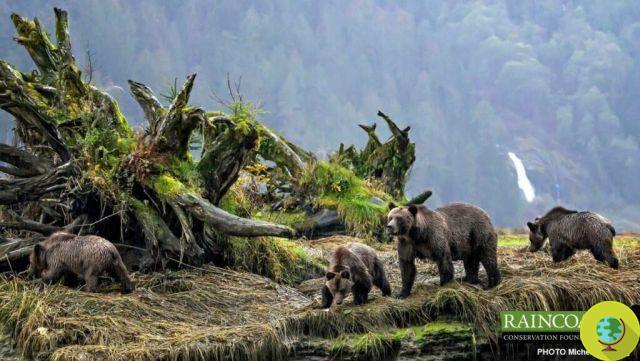
The territories inhabited by genetically similar and indigenous grizzly bears belonging to the same language family correspond
He is about to end up run over, his mother saves himThe bears and natives of coastal British Columbia have more in common than meets the eye ... a "jaw-dropping" discovery that shows how cultural and biological diversity in the region are intertwined
Bears and indigenous peoples of British Columbia, on the west coast of Canada, have shared the same territories for millennia. This was known, but what surprised the researchers involved in a study published in Ecology and Society was the DNA analysis of bears.
Analysis that allowed us to discover that the grizzlies that inhabit these lands form 3 distinct genetic groups, closely aligned with three indigenous language families of the region. That is, the territories inhabited by grizzly bears correspond to the maps of indigenous language families. Proof that cultural and biological diversity are deeply intertwined.
The research began as a genetic study. Grizzlies were colonizing islands along the British Columbia coast, a move that had intrigued scientists and wildlife managers there. Who wanted to understand the reason for this move. A working group was formed which was later joined by Lauren Henson of the University of Victoria, the geographer who led the research published in Ecology and Society, interested in understanding which continental grizzlies were genetically more similar to those of the islands.
The team, for 11 years, collected samples of 147 bears spread across a territory of about 38.000 square kilometers, reaching the most remote regions of British Columbia. Here he placed piles of leaves and twigs coated with a mixture of dogfish oil and fish-based slurry. The piles have been surrounded with barbed wire, harmless to bears but useful for catching tufts of fur.
The researchers then examined the collected hairs and microsatellite DNA markers, and found that there were 3 genetically distinct groups of grizzlies. However, there were no physical barriers that kept them separate, the borders between the different genetic groups were not in fact found in correspondence with streams or harsh landscapes.
Ma the different territories they inhabited geographically overlapped with three indigenous linguistic families: Tsimshian, Wakashan and Salishan Nuxalk. The researchers found that grizzly bears that lived within the boundaries of a language family were much more genetically similar to each other than bears that lived outside them.
This shows that humans and bears are deeply connected as they share many similar needs in terms of space, food and other resources. And that the territory has influenced the distribution of the grizzly bear in the same way it has influenced the natives living in the same territories.
A discovery that, among other things, highlights the importance of local monitoring and localized management of bears, as pointed out by William Housty of the Heiltsuk Integrated Resource Management Department.
Follow us on Telegram | Instagram | Facebook | TikTok | Youtube
SOURCE: Ecology and Society/Science
Read also:
- Arthur, the largest bear in Romania, was brutally killed: the prince of Liechtenstein was accused
- Ice Age cave bear found in Russia after permafrost melting


























